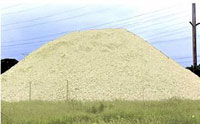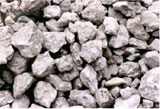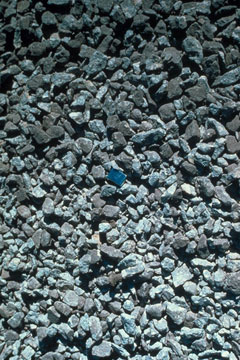
Construction materials are increasingly judged by their ecological characteristics. Concrete recycling gains importance because it protects natural resources and eliminates the need for disposal by using the readily available concrete as an aggregate source for new concrete or other applications. According to a
2004 FHWA study, 38 states recycle concrete as an aggregate base; 11 recycle it into new portland cement concrete. The states that do use recycled concrete aggregate (RCA) in new concrete report that concrete with RCA performs equal to concrete with natural aggregates. Most agencies specify using the material directly in the project that is being reconstructed.
Recycling of concrete is a relatively simple process. It involves breaking, removing, and crushing existing concrete into a material with a specified size and quality. See ACI 555 (2001) for more information on processing old concrete into recycled concrete aggregates. The quality of concrete with RCA is very dependent on the quality of the recycled material used. Reinforcing steel and other embedded items, if any, must be removed, and care must be taken to prevent contamination by other materials that can be troublesome, such as asphalt, soil and clay balls, chlorides, glass, gypsum board, sealants, paper, plaster, wood, and roofing materials.
Applications
In general, applications without any processing include:
- many types of general bulk fills
- bank protection
- base or fill for drainage structures
- road construction
- noise barriers and embankments
Most of the unprocessed crushed concrete aggregate is sold as 1½ inches or 2 inches fraction for pavement subbases.
After removal of contaminants through selective demolition, screening, and /or air separation and size reduction in a crusher to aggregate sizes, crushed concrete can be used as: new concrete for pavements, shoulders, median barriers, sidewalks, curbs and gutters, and bridge foundations structural grade concrete soil-cement pavement bases lean-concrete or econo-crete bases and bituminous concrete.
Recycled Aggregate Characteristics
 The crushing characteristics of hardened concrete are similar to those of natural rock and are not significantly affected by the grade or quality of the original concrete. Recycled concrete aggregates produced from all but the poorest quality original concrete can be expected to pass the same tests required of conventional aggregates.
The crushing characteristics of hardened concrete are similar to those of natural rock and are not significantly affected by the grade or quality of the original concrete. Recycled concrete aggregates produced from all but the poorest quality original concrete can be expected to pass the same tests required of conventional aggregates.
Recycled concrete aggregates contain not only the original aggregates, but also hydrated cement paste. This paste reduces the specific gravity and increases the porosity compared to similar virgin aggregates. Higher porosity of RCA leads to a higher absorption.
Mix Design
It is generally accepted that when natural sand is used, up to 30 percent of natural crushed coarse aggregate can be replaced with coarse recycled aggregate without significantly affecting any of the mechanical properties of the concrete. As replacement amounts increase drying shrinkage and creep will increase and tensile strength and modulus of elasticity will decrease, however compressive strength and freeze-thaw resistance are not significantly affected. For more information, click here.
It is recommended that RCA be batched in a prewetted and close to a saturated surface dry condition, like lightweight aggregates. To achieve the same workability, slump, and water-cement ratio as in conventional concrete, the paste content or amount of water reducer generally have to be increased.
Concrete with RCA can be transported, placed, and compacted in the same manner as conventional concrete. Special care is necessary when using fine RCA. Only up to 10 to 20 percent fine RCA is beneficial. The aggregate should be tested at several substitution rates to determine the optimal rate.
Often recycled aggregate is combined with virgin aggregate when used in new concrete. An example of a mix design using recycled aggregates in a pavement application is shown following table.
Sustainability
Recycling concrete provides sustainability several different ways. The simple act of recycling the concrete reduces the amount of material that must be landfilled. The concrete itself becomes aggregate and any embedded metals can be removed and recycled as well. As space for landfills becomes premium, this not only helps reduce the need for landfills, but also reduces the economic impact of the project. Moreover, using recycled concrete aggregates reduces the need for virgin aggregates. This in turn reduces the environmental impact of the aggregate extraction process. By removing both the waste disposal and new material production needs, transportation requirements for the project are significantly reduced.
In addition to the resource management aspect, recycled concrete aggregates absorb a large amount of carbon dioxide from the surrounding environment. The natural process of carbonation occurs in all concrete from the surface inward. In the process of crushing concrete to create recycled concrete aggregates, areas of the concrete that have not carbonated are exposed to atmospheric carbon dioxide.
The LEED® Green Building Rating System recognizes recycled concrete in its point system. Credit 4 (Materials and Resources) states, “specify a minimum of 25 percent of building materials that contain in aggregate a minimum weighted average of 20 percent post-consumer recycled content material, OR, a minimum weighted average of 40 percent post-industrial recycled content material.” Using recycled aggregates instead of extracted aggregates would qualify as post-consumer. Because concrete is an assembly, its recycled content should be calculated as a percentage of recycled material on a mass basis.
Credit can also be obtained for Construction Waste Management. It is awarded based on diverting at least 50 percent by mass of construction, demolition, and land clearing waste from landfill disposal. Concrete is a relatively heavy construction material and is frequently recycled into aggregate for road bases or construction fill.
Case Study: O’Hare Modernization Project
 Recycled concrete aggregates are being considered for use in the O’Hare Modernization Project (OMP). Laboratory testing using a two-stage mixing method showed that using RCA from Chicago O’Hare International Airport for the coarse aggregate reduces bleeding and segregation and produces similar workability, compressive strength, and shrinkage as virgin aggregates.
Recycled concrete aggregates are being considered for use in the O’Hare Modernization Project (OMP). Laboratory testing using a two-stage mixing method showed that using RCA from Chicago O’Hare International Airport for the coarse aggregate reduces bleeding and segregation and produces similar workability, compressive strength, and shrinkage as virgin aggregates.
In October of 2009, a field test of RCA was initiated in two lanes at Gate F7B. In a side-by-side comparison, a lane of concrete using virgin aggregates was placed next to a lane of concrete using RCA. The RCA was produced on-site using concrete removed at the airport. The ready mixed concrete supplier treated the RCA like lightweight aggregates and was able to produce concrete in a single-stage mixing process. Contractors placing the RCA concrete said the workability was similar to that of the virgin aggregate concrete and the placement had good finishability. Within four days, the placement was in full service.
Sensors were placed in the concrete at the time of placement to measure the internal relative humidity, temperature, and the lift-off of the slab from the cement-treated permeable base. Other properties were regularly monitored, such as surface appearance and joint width. After five months of monitoring, the data between the two concrete lanes are statistically the same, showing no difference in behavior between the RCA concrete and virgin aggregate concrete.
For more information, contact the Center of Excellence for Airport Technology at the University of Illinois.
References
ACI Committee 555, Removal and Reuse of Hardened Concrete, ACI 555R-01, ACI Committee 555 Report, American Concrete Institute, Farmington Hills, Michigan, 2001, 26 pages.
FHWA, Transportation Applications of Recycled Concrete Aggregate, Federal Highway Administration, Washington, D.C., September 2004, 47 pages.